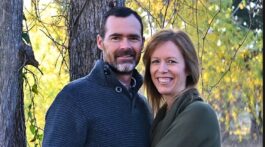In October 2023, I had the pleasure of presenting a paper at the North American Division’s Women in Adventist History Conference. My paper, “The Invisible Seventh-day Adventist Medical Cadet Corps: Women in a Man’s World,” briefly explored the lives of four women who at one time or another were involved in the Medical Cadet Corps between 1938 and 1958. Limited to only twenty minutes in which to speak, my research retrieved far more material than I had time to share then. Thus, it is my privilege in this article, and in others in this series, to more fully explore the lives and contributions of these four women in addition to two more women who should have been included in the original presentation. Part 1 explored the life of Verna Lucille Robson; Part 2 introduced Kathryn Luella Jenson Nelson; Part 3 presented Josephine Rose Steinkraus Stone. For the duration of the Medical Cadet Corps (MCC), Missionary Volunteer secretary-directors were vital to the operation of the MCC. Usually men, they simultaneously served as educational superintendents, War Service Commission representatives, and sometimes Sabbath School or home mission (personal ministries) secretaries for their respective conferences. Part 4 introduces a few women who were their colleagues.
In 1940, Louise C. Kleuser (1890-1976) in the Greater New York Conference and Marion G. Seitz (1907-2002) in the Alabama-Mississippi Conference were two of only four women serving as combined educational superintendents and Missionary Volunteer secretary-directors in the United States. The other two were Sybil Mary (Billington) King (1885-death date unknown) and Rachel Anna Knight (1874-1972) in the Southern Union Colored Department. It appears that neither King nor Knight were active in the MCC. However, Kleuser took Medical Cadet Corps officer training with the men in 1941, achieving the rank of second lieutenant. She believed that she was the first woman to train with the men; however, the year before, in August 1940, 32-year-old Marion G. Seitz had already become the first woman to do so. (Learn more about Louise C. Kleuser and Rachel Anna Knight in the Encyclopedia of Seventh-day Adventists).
Early Years
Marion G. Seitz was born to Frank Albert and Edith (Briddon) Seitz (1874-1940; 1880-1954) on September 14, 1907. The Seitz family lived in Rochester, New York. Frank was of German and Dutch heritage; Edith was born in England. They were humble people. Frank was a school janitor in Rochester for many years and may have later become a sanitation engineer. In their later years, the couple retired in Union Springs, New York.
The family included three children with Marion in the middle. Her older sister, Ruth E[dith?] (1901-1988), became a school teacher and married John Frederick Bohner. Her younger brother, Melville Frank (1914-1947), served as a missionary doctor and died in Baghdad, Iraq.
The place of Marion’s early education is unknown, but she was attending Fernwood Academy (1920-1921), a predecessor of Union Springs Academy, in 1921 when it burned. Thereafter, Marion enrolled at Union Springs Academy where she completed her secondary education in 1923. Following secondary school graduation, Seitz taught at the Rochester, New York, church school, although it is uncertain what credentials enabled her to teach. Evidently, she took some course work at Atlantic Union College in the summers, beginning in 1924, but she did not complete the normal (teacher training) course until 1933. For the next five years, she continued to teach in New York, spending at least two years as Union Springs Academy’s elementary school and another year in New York City.
In the MCC
In 1937, the Alabama-Mississippi Conference called Seitz to become its educational and young people’s Missionary Volunteer secretary. Her responsibilities included oversight of the conference’s elementary schools and the MV program. After the General Conference adopted the Medical Cadet Corps plan in October of 1939, MV leaders across the United States were called upon to recruit cadets, schedule training camps, organize local MCC units within their conferences, and generally support the program. This also meant that most MV secretaries were expected to go through MCC training, usually the officer course. Many of the men believed they deserved ranks as officers due to their church administrative positions rather than ability or knowledge of things medical-military—a point of contention for Everett Dick. Seitz, it turns out, possessed the good sense, leadership ability, and skill to excel in the MCC.
Although little noted at the time because emphasis was always placed on the men who may soon find themselves drafted, Seitz gamely attended the training camp sponsored by the Columbia Union Conference from August 18 to September 1, 1940. Columbia Union MV secretary Chris P. Sorensen was in charge of MCC training in the entire eastern region of the United States; thus, cadets and officer candidates from the Atlantic and Southern unions were also invited to the camp held in an old Civilian Conservation Corps camp in Birdsboro, not far from Reading, Pennsylvania. Today the place is French Creek State Park. In 1940 Adventists were already familiar with it as the rented location for the Eastern Pennsylvania junior camp.
Over the course of two weeks, Sorenson promised participants that they would complete the 44-hour Basic and Litter Drill and 30-hour Studies in Noncombatancy sections of the MCC curriculum. Elements of Camp Sanitation and Hygiene were included as time permitted, but camp registrants were on their own to complete the standard and advanced Red Cross First Aid courses that were par to the MCC on college campuses. The complete MCC curriculum comprised 216 hours.
The MCC training camp was open to 150 cadets. About thirty officer candidates presented themselves, and even fewer cadets attended this inaugural event. Seitz was the lone woman in the group. According to Everett Dick, who also attended this camp, Seitz was
… very excellent. So much so that I very shortly made her squad leader and the rest of the fellas called her the “Petticoat Corporal.” The men in the officer training respected her because she was excellent. A few months later when she invited me to come and inspect her corps that she had raised in the Alabama-Mississippi conference I found she had a very excellent corps going there in Birmingham. (Everett Dick Memoirs recorded for his family)
As Seitz remembered it, she was one woman among about thirty men, a few of whom found it difficult to salute her. Sorensen also “well remember[ed]” that Seitz was the only woman. (Correspondence between Seitz-Simmons and Sorensen in the General Conference Archives)
Seitz’s tenure with the MCC does not seem to have lasted long. She did help organize the MCC in the Alabama-Mississppi conference. In addition to the Birmingham MCC, she attended the first graduation of MCC cadets at Oakwood Junior College where she assisted in awarding thirty-three students their certificates on May 3, 1941. Thereafter, further evidence that she worked with the MCC is scant if it exists at all.
Later Career
One of the reasons that little was published about her work between 1941 and 1943 was that she returned to college on a part time basis to complete her Bachelor’s degree. She attended Madison College, which was unaccredited, thus she took her final nine or ten credits from Peabody College in Nashville to “establish” her Madison College degree. Different accounts have her graduating from Madison College in 1942 and 1943. Likely, she finished her course work at Madison in 1942, and at Peabody in 1943. Regardless, she graduated in absentia because by 1943, she had moved to the Georgia-Cumberland Conference, where she also served as educational and MV secretary until 1946. About that time, she married James Douglas Simmons (1899-1963), a businessman from Chicago who had a second career as credit manager of Adventist sanitariums in Madison, Tennessee; Washington, DC; and Florida.
After their marriage, Seitz-Simmons continued her career in education. In 1951 while her husband worked at the Washington Sanitarium in Takoma Park, Maryland, she earned a master’s degree from the University of Maryland and chaired the education department at Columbia Union College (now Washington Adventist University). When they returned to Madison College, she served as chair of the Education Department from 1954 to 1959. She also became a student educational consultant for Southern Missionary College (now Southern Adventist University) and associate secretary for education in the Florida Conference. Throughout these years, she also furthered her education with special courses at Andrews University, the University of Tennessee, and University of Florida.
Two years after her husband died of a heart attack in 1963, Seitz-Simmons returned to the Atlantic Union Conference to serve as elementary supervisor for the union. Then at an age one might expect her to retire, she accepted a call to the Far Eastern Division in 1968. She moved to Singapore where she served the division for nearly six years as an associate in the education department. She retired in 1974, but her career was not over yet. She soon took up Sustentation Overseas Service (SOS), a program which allowed retired denominational employees to provide assistance in international fields. As an SOS worker, Seitz-Simmons traveled to “Ceylon [Sri Lanka], Pakistan, India, Guam-Micronesia Mission and two times in Bangkok, Thailand.” Her experiences ranged from “pastor of the Adventist Hospital Church” to “ House Mother for 130 student nurses at Bangkok Adventist Hospital.” (The Madison Survey and Alumni News, September 1983, pg. 9). In the mid-1980s, she finally slowed down and retired to Hendersonville, North Carolina. She passed away on June 11, 2002, in Fletcher, North Carolina.
Marion G. Seitz-Simmons was a truly remarkable woman, although one who has been forgotten. In her lifetime she was highly regarded and respected as a teacher, administrator, and mentor. She deserves to be remembered for her more than fifty years of dedicated service to Adventist education.










